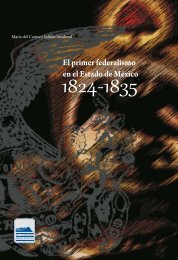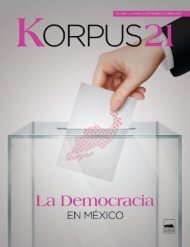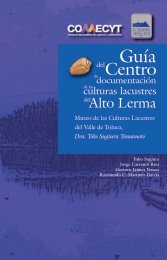Create successful ePaper yourself
Turn your PDF publications into a flip-book with our unique Google optimized e-Paper software.
KORPUS <strong>21</strong>, VOL. 4, NÚM. <strong>10</strong>, 2024, 67-78<br />
than would be true in a very well-connected,<br />
well-visited, long-established convent such as<br />
Santa Catarina.<br />
Exacerbating this relative lack of connection<br />
between the convent and the town was the fact<br />
that the only nuns whose families lived in or near<br />
San Miguel were the foundress, two of her sisters,<br />
and two others, whereas in the other convents<br />
in the bishopric it was much more likely<br />
that the nuns would come from the city where<br />
the convent was located. 16<br />
Social status<br />
I did not discern signs of tension along lines of<br />
class or status, for example, factions that consisted<br />
of young women whose family had been<br />
able to afford a dowry (at 3000 pesos, not a<br />
small sum) pitted against young women who<br />
did not have family money for a dowry and had<br />
to either win a scholarship (music, bookkeeping),<br />
claim one of the dowries set aside for poor<br />
but deserving aspirants, or spend years as a<br />
niña hoping to accumulate a dowry by cultivating<br />
benefactors. The rebellious and the obedient<br />
nuns during the time of the rebellion were<br />
all overwhelmingly dowried —only four out of <strong>21</strong><br />
came from families that could not pay a dowry.<br />
The proportion of poorer nuns increased over<br />
the convent’s history, slowly at first. From 1768<br />
to 1774 only four out of 18 nuns were either former<br />
donadas (who, in another unusual constitutional<br />
provision at La Purísima, were allowed<br />
to profess as white veil nuns after ten years of<br />
service), received a scholarship, or were granted<br />
a dowry set up by a patron or provided by a<br />
benefactor. From 1775 to 18<strong>10</strong> seven out of 26<br />
fell into these categories of poorer nuns. And by<br />
the post-18<strong>10</strong> era 14 out of the 18 nuns who professed<br />
were too poor to bring a dowry, including<br />
five of the six admitted in 1854. Thus the last<br />
generation and a half of women admitted during<br />
the colonial period (1792-18<strong>10</strong>) might have seen<br />
themselves as fundamentally different from the<br />
younger women admitted in the late 1820s and<br />
16 In the Santa Catarina convent, over the course of the<br />
eighteenth century, one-third of the nuns in the convent<br />
came from Valladolid itself and another 24% came from<br />
towns within a day’s visit of the convent; in the convent of<br />
Nuestra Señora de la Salud 52% came from Pátzcuaro and<br />
another 18% came from nearby towns; and in the convent of<br />
Santa Clara in Querétaro, half the nuns came from the city<br />
of Querétaro itself. Data on Santa Clara from Gallagher, <strong>10</strong>9.<br />
early 1830s who were, as a group, considerably<br />
less prominent and less wealthy than they were.<br />
However, while differences of class and wealth<br />
may have fed tensions through the late 1830s<br />
and into the 1840s, they seem likely to have<br />
faded by mid-century time as root causes for<br />
intra-conventual tensions, for the simple reason<br />
that by mid-century virtually no one came from<br />
a wealthy or prominent family.<br />
Conclusion<br />
Rebellious Nuns would have been a very different<br />
book if I had just focused on the rebellions.<br />
Adopting a biographical approach enabled me<br />
to see things in the way the convent started its<br />
“life” (its constitution, its founders, the nuns’ built<br />
environment) that helped explain the rebellions<br />
more fully than just reconstructing the events. A<br />
biographical perspective also helped me gauge<br />
the importance of the rebellions vs. the financial<br />
crisis in the convent’s historical dysfunctionality.<br />
And prosopography crucially showed how rebellion<br />
and financial crisis were cause and consequence<br />
of recruitment problems, which had<br />
multiple faces (an aging population, a poorer<br />
population, a population with an unusual degree<br />
of unorthodox (orphaned, illegitimate) family<br />
backgrounds. These biographical and prosopographical<br />
methods and approaches yielded a rich<br />
explanation of the convent’s troubled history.<br />
References<br />
AGN (Archivo General de la Nación) (1801), “Vicario<br />
Ignacio Antonio de Palacios a Obispo Fray Antonio<br />
de San Miguel”, 8 de julio, Templos y Conventos,<br />
vol. 6, exp. 1.<br />
AHAMich (Archivo Histórico del Arzobispado de Michoacán)<br />
(1857), “Puntos que han visitado las<br />
monjas de la Concepción en los escrutinios para<br />
el capítulo de octubre 1857”, Diocesano, Gobierno,<br />
Religiosos, Concepcionistas, caja 376 (XIX),<br />
exp. 52.<br />
AHAMich, (Archivo Histórico del Arzobispado de Michoacán)<br />
(1851), Vicario Maximiano Moncada a<br />
Vicario General, 17 de julio, Diocesano, Gobierno,<br />
Religiosas, Concepcionistas, caja 376 (XIX),<br />
exp. 52.<br />
75


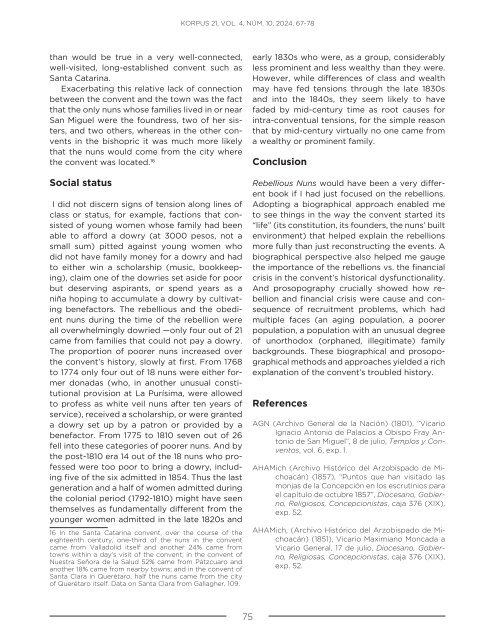
![bicentenario_1[V2]](https://img.yumpu.com/68677971/1/167x260/bicentenario-1v2.jpg?quality=85)
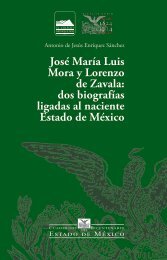
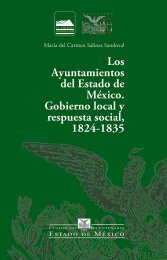

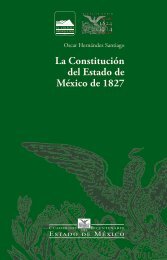
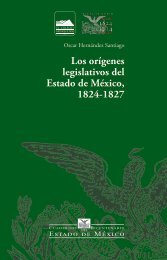
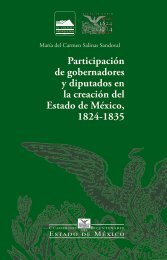
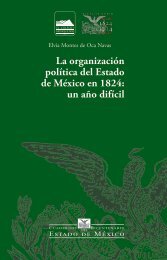
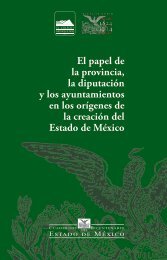
![El_primer_federalismoEM[final]_compressed (2)](https://img.yumpu.com/68483279/1/178x260/el-primer-federalismoemfinal-compressed-2.jpg?quality=85)
